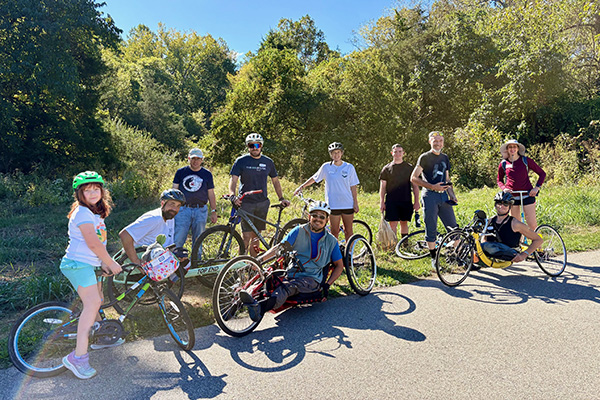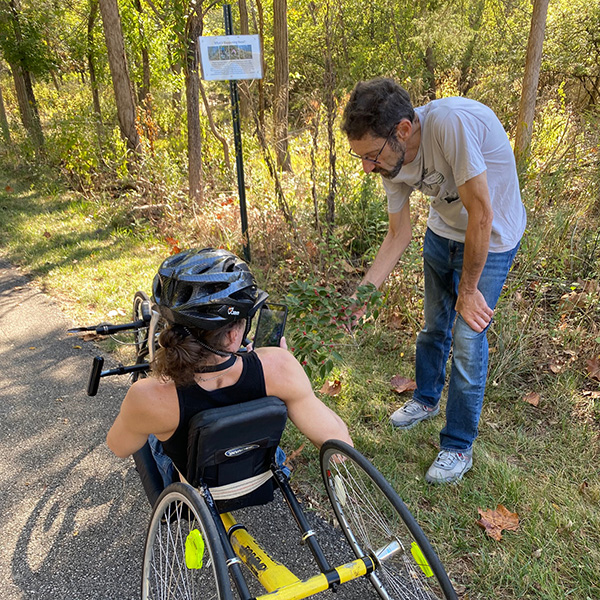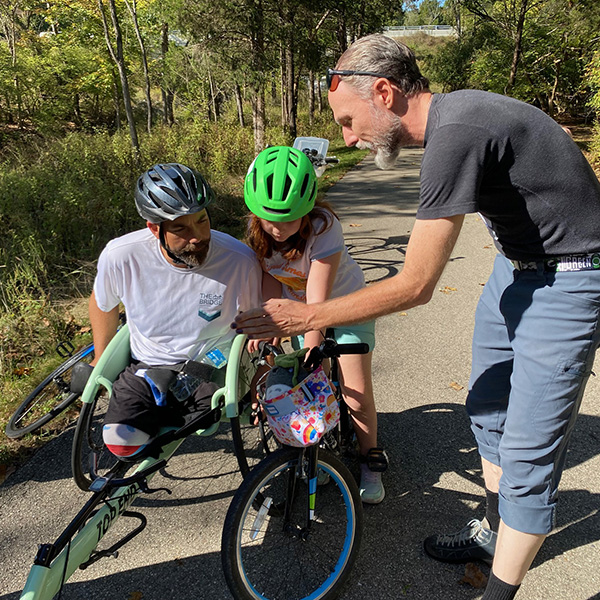Miami biologists share knowledge during first Adaptive Nature Walk on Wheels
Event introduced ‘the fun of learning about nature and biology to the disability community while also introducing the disability community to my science colleagues,’ organizer said

Miami biologists share knowledge during first Adaptive Nature Walk on Wheels
Hillsboro handcyclist Bart Burgess was at a mountain bike meet with members of the Bridge Adaptive Sports and Recreation this summer when handcyclist Yoshi Tomoyasu, associate professor of Biology at Miami University, caught a cicada.
“He caught one by hand and he kind of gave us all a class on cicadas, and I thought that was very interesting,” Burgess said before the first Adaptive Nature Walk on Wheels got underway Sunday in Oxford. “When I saw he was doing this, I was like ‘man, if it’s anything like him talking about cicadas, I have to catch that.’”
Tomoyasu organized the event and was joined by other Miami biologists who shared their knowledge and interesting tidbits as the group made their way down the trail on handcycles, bicycles, or on foot. Participants could also look up more specific details on the iNaturalist app they downloaded on their phones.
The field trip took place on paved trails through scenic autumn woods on the city’s Oxford Area Trails (OATS) that meander through the Miami University Natural Areas. Participants learned about Ohio’s native habitats, local wildlife, and the impact of invasive species.

New discoveries
Dave Gorchov, professor of Biology and chair of the Miami University Natural Areas committee, stood near one area where volunteers have been clearing away invasive honeysuckle so trail users will be able to see nearby Collins Creek.
He also held a branch of honeysuckle to illustrate “deer browse," which is when whitetail deer eat the leaves. “They don’t bite with their teeth. They use their lips” and pull back on the leaves, stripping them from the stems, Gorchov said.
Other biologists who participated were Deidra Jacobsen, assistant professor of Biological Sciences and director of The Conservatory at Miami Hamilton; Richard Moore, professor of Biology; and Steve Sullivan, director of Miami's Hefner Museum of Natural History.
Sullivan, an avid cyclist, often rides on the trails and was excited to participate in the event.
“My main role is to ride along, and when I see something that I think would be of interest to folks from the natural world, to show it to them, and explain not just why it’s cool but how it relates to all of us,” he said, later showing participants a tiny, camouflaged ambush bug, known for patiently waiting on flowers to prey on bees, flies, and other insects.

The Bridge
The event was co-sponsored by Cincinnati-based the Bridge Adaptive Sports and Recreation, commonly known as the Bridge.
Tomoyasu became a member after he was paralyzed below the waist in a 2021 rock-climbing accident. He worked his way back to teaching and his research lab at Miami as well as his active lifestyle.
“One big thing after the injury was a loss of connection to nature. I felt a huge loss,” he said as participants gathered at the DeWitt Cabin parking area along Oxford Trenton Road before the event. “I’m trying to find a way to go back to nature. This is one of my attempts, and also to share with others.”
Danny Meyer, executive director of the Bridge, said this was the organization’s first visit to Oxford with its adaptive equipment (in this case handcycles) that could be used on the paved trails.
Adaptive or accessible design of parks and trails is important, Meyer said, calling it universal design. “It’s creating a space where regardless of your ability, whether you’re a beginning cyclist or you’re in a wheelchair, you all need the same style of trails. It’s thinking proactively about that.”
Miami alumna Audrey Van Auken ’18, who earned a degree in Athletic Training, is the Bridge’s operations manager and first full-time employee.
“Yoshi is one of our best handcyclists, so being able to do something that supports him in handcycling and also in his academic endeavors is great,” said Van Auken, who first discovered the Oxford trails as a Miami student and later as an associate athletic trainer working with athletic teams.
Handcyclist Jacob Counts of Fort Mitchell, Kentucky, came with his 8-year-old daughter, A.J., for the chance to ride with Yoshi and learn from the biologists.
“Me and my daughter enjoy riding and enjoy nature, and it seemed like a good opportunity to do something with the disability community where we’re engaging in sport but also learning something new,” Counts said.
Tomoyasu called the first Adaptive Nature Walk a success.
“Using iNaturalist was super fun, together we made 72 observations and identified 44 species,” he wrote in a Facebook post afterward. “This event is something I have really wanted to organize, introducing the fun of learning about nature and biology to the disability community, while also introducing the disability community to my science colleagues. I believe we can learn so much from each other.”